http://www.wirelesscommunication.nl/reference/chaptr05/ofdm/ofdm.htm
Orthogonal Frequency Division Multiplexing
Orthogonal Frequency Division Multiplexing (OFDM) is special form of multi-carrier modulation, patented in 1970. It is particularly suited for transmission over a dispersive channel. (See further discussion of MCM over wireless channel.)In a multipath channel, most conventional modulation techniques are sensitive to intersymbol interference unless the channel symbol rate is small compared to the delay spread of the channel. OFDM is significantly less sensitive to intersymbol interference, because a special set of signals is used to build the composite transmitted signal. The basic idea is that each bit occupies a frequency-time window which ensures little or no distortion of the waveform. In practice, it means that bits are transmitted in parallel over a number of frequency-nonselective channels. Applications of OFDM are found in- Digital Audio Broadcasting (DAB) and
- Digital Video Broadcasting over the terrestrial network: Digital Terrestrial Television Broadcasting (DTTB). In the DTTB OFDM transmission standard, about 2,000 to 8,000 subcarriers are used.
- UMTS. The UMTS Forum is selecting an appropriate radio solution for the third generation mobile standard, as a successor to GSM. OFDM is one of the five competing proposals.
- Wireless LANs. OFDM is used in HIPERLAN Phase II, which supports 20 Mbit/s in propagation environments with delay spreads up to 1 msecond.
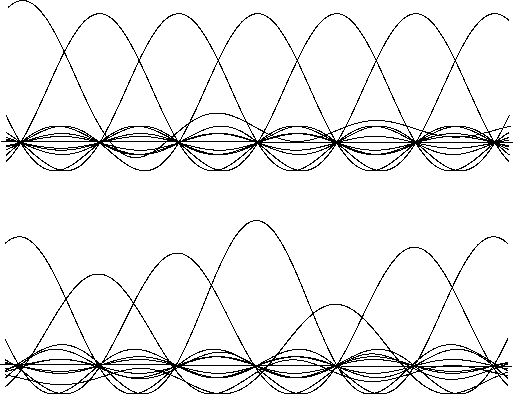
Figure: Signal spectrum of an OFDM signal, which consists of the spectra of many bits, in parallel. Rectangular pulses in time domain produce sinc-functions in frequency domain.
- Above: signal spectrum as transmitted.
- Below: as received in over a dispersive, time-invariant channel.
 The effect of multipath scattering on OFDM differs from what happens to other forms of modulation. A qualitative description and mathematical description of OFDM is presented by Dusan Matic. Jean-Paul Linnartz reviews the effects of a Doppler spread and the associated rapid channel variations. Dusan Matic also studied the system design aspects of OFDM at mm-wavelengths.
The effect of multipath scattering on OFDM differs from what happens to other forms of modulation. A qualitative description and mathematical description of OFDM is presented by Dusan Matic. Jean-Paul Linnartz reviews the effects of a Doppler spread and the associated rapid channel variations. Dusan Matic also studied the system design aspects of OFDM at mm-wavelengths.
 Exercise
Exercise
Consider two subcarrier signals, modulated with rectangular pulse shape of duration T. For which frequency offsets are the signals orthogonal? What is the effect of a mild channel dispersion on the orthogonality of the signals? Are the signals still orthogonal if the channel is changing rapidly?Coded OFDM
Multi-Carrier Modulation on its own is not the solution to the problems of communication over unreliable multipath channels. The channel time dispersion will excessively attenuate some subcarriers such that the throughput on these sub-channels would be unacceptable small. Only if the joint signal of many subcarriers is processed appropriately, the diversity advantages of MCM can be exploited. The need for coding across subcarriers was addressed by Sari et al. warning against overly enthusiastic pursuit of MCM. The advantages of frequency-domain implementations of equalizers (using an FFT) should not be mistaken for an "inherent" diversity gain of OFDM, which may not exist.| Coding for wireless Turbo coding for OFDM Frequency Diversity |
In an OFDM transmitter, blocks of k incoming bits are encoded into n channel bits. Before transmission, an n-point Inverse-FFT operation is performed. When the signals at the I-FFT output are transmitted sequentially, each of the n channel bits appears at a different (subcarrier) frequency. Such coding across subcarriers is necessary. If one subcarrier experiences deep fading, this leads to erasure of the bit on this subcarrier.
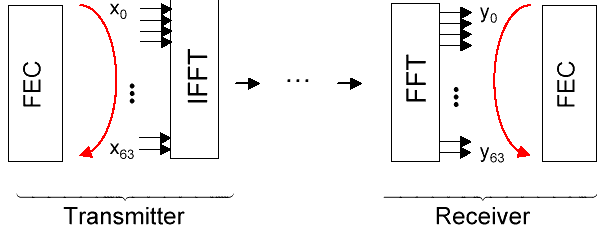
- Interleaving in frequency or time domain with coding in the other domain,
- The use of different signal constellations at different frequencies, i.e., adapting the subcarrier bit rate to the channel state,
- Signal spreading over various subcarriers, e.g., according to a linear matrix operation, as is proposed in Orthogonal Multi-Carrier Code Division Multiplexing.
Implementational Aspects
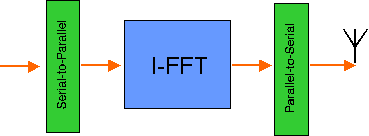 | Figure: OFDM transmitter using an (inverse) Fast Fourier Transform (FFT). |
- OFDM is not a constant-envelope modulation method. Therefore transmit power amplifiers must be highly linear.
- OFDM receiver performance is very sensitive to phase noise.
- Synchronization to an OFDM signal also requires frame synchronization, to support an FFT operation at the receiver.
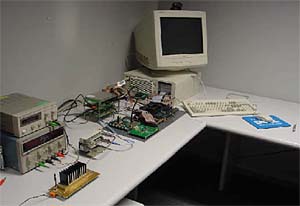 | Figure: Experimental OFDM transceiver at IMEC, Leuven. Slides from IMEC tutorials: intro, turbo coding, turbo for OFDM | 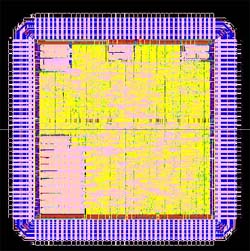 |
Single Frequency Networks
OFDM allows very efficient frequency reuse. Transmitters broadcasting the same program can use the same frequency in a Single Frequency Network.Code Division Multiple Access
OFDM can be combined with CDMA transmission, e.g. in Multi-Carrier CDMA.Channel Modeling
Many channel simulation models follow the narrowband model. Wideband channels are often simulated by extending the model assuming multiple time-delayed resolvable paths. This allows the simulation of the channel impulse response, including its stochastic behavior. To determine the performance of an multicarrier, OFDM or MC-CDMA system, another approach can be to model a set of fading subchannels. Considering a single subcarrier, the channel may be modelled as a narrowband fading channel, for instance with Rician or Rayleigh amplitude distributions. The collection of multiple subcarriers can be modelled as a set of mutually dependentfading channels. In such model, it is important to address correlation of the fading of various subchannels using the models of delay spread and coherence bandwidth. See a discussion of such model. Also: read about thediscrete-frequency model for OFDM with Delay spread and Doppler. | Listen to an MP3 audio program about on OFDM, featuring Jeff Anderson (SONY), Geert Awater (Lucent), Helmut Boelsckei (Stanford U.) and Jean-Paul Linnartz (Philips). |
| SMIL Synchronous Multimedia | Animated audio tutorial on OFDM and MC-CDMA |
http://blog.oureducation.in/important-questions-on-ofdm/
1) What is OFDM?
Ans: OFDM (Orthogonal Frequency Division Multiplexing) is a broadband multicarrier modulation method that offers superior performance and benefits over older, more traditional single-carrier modulation methods because it is a better fit with today’s high-speed data requirements and operation in the UHF and microwave spectrum.
Ans: OFDM (Orthogonal Frequency Division Multiplexing) is a broadband multicarrier modulation method that offers superior performance and benefits over older, more traditional single-carrier modulation methods because it is a better fit with today’s high-speed data requirements and operation in the UHF and microwave spectrum.
2) How does OFDM work?
Ans: OFDM is based on the concept of frequency-division multiplexing (FDD), the method of transmitting multiple data streams over a common broadband medium. That medium could be radio spectrum, coax cable, twisted pair, or fiber-optic cable. Each data stream is modulated onto multiple adjacent carriers within the bandwidth of the medium, and all are transmitted simultaneously. A good example of such a system is cable TV, which transmits many parallel channels of video and audio over a single fiber-optic cable and coax cable.
Ans: OFDM is based on the concept of frequency-division multiplexing (FDD), the method of transmitting multiple data streams over a common broadband medium. That medium could be radio spectrum, coax cable, twisted pair, or fiber-optic cable. Each data stream is modulated onto multiple adjacent carriers within the bandwidth of the medium, and all are transmitted simultaneously. A good example of such a system is cable TV, which transmits many parallel channels of video and audio over a single fiber-optic cable and coax cable.
3) Why has there been all the interest in OFDM in the past few years?
Ans: OFDM has been adopted as the modulation method of choice for practically all the new wireless technologies being used and developed today. It is perhaps the most spectrally efficient method discovered so far, and it mitigates the severe problem of multipath propagation that causes massive data errors and loss of signal in the microwave and UHF spectrum.
Ans: OFDM has been adopted as the modulation method of choice for practically all the new wireless technologies being used and developed today. It is perhaps the most spectrally efficient method discovered so far, and it mitigates the severe problem of multipath propagation that causes massive data errors and loss of signal in the microwave and UHF spectrum.
4) Name some of the wireless technologiesthat use OFDM?
Ans: The list is long and impressive. First, it is used for digital radio broadcasting. It is used in TV broadcasting.You will also find it in wireless local-area networks (LANs) like Wi-Fi. The wideband wireless metro-area network (MAN) technology WiMAX uses OFDM. And, the almost completed 4G cellular technology standard Long-Term Evolution (LTE) uses OFDM. The high-speed short-range technology known as Ultra-Wideband (UWB) uses an OFDM standard set by the WiMedia Alliance. OFDM is also used in wired communications like power-line networking technology. One of the first successful and most widespread uses of OFDM was in data modems connected to telephone lines. ADSL and VDSL used for Internet access use a form of OFDM known as discrete multi-tone (DMT). And, there are other less well known examples in the military and satellite worlds.
Ans: The list is long and impressive. First, it is used for digital radio broadcasting. It is used in TV broadcasting.You will also find it in wireless local-area networks (LANs) like Wi-Fi. The wideband wireless metro-area network (MAN) technology WiMAX uses OFDM. And, the almost completed 4G cellular technology standard Long-Term Evolution (LTE) uses OFDM. The high-speed short-range technology known as Ultra-Wideband (UWB) uses an OFDM standard set by the WiMedia Alliance. OFDM is also used in wired communications like power-line networking technology. One of the first successful and most widespread uses of OFDM was in data modems connected to telephone lines. ADSL and VDSL used for Internet access use a form of OFDM known as discrete multi-tone (DMT). And, there are other less well known examples in the military and satellite worlds.
5) How is OFDM implemented in the real world?
Ans: OFDM is accomplished with digital signal processing (DSP). We can program the IFFT and FFT math functions on any fast PC, but it is usually done with a DSP IC or an appropriately programmed FPGA or some hardwired digital logic. With today’s super-fast chips, even complex math routines like FFT are relatively easy to implement. In brief, we can put it all on a single chip.
Ans: OFDM is accomplished with digital signal processing (DSP). We can program the IFFT and FFT math functions on any fast PC, but it is usually done with a DSP IC or an appropriately programmed FPGA or some hardwired digital logic. With today’s super-fast chips, even complex math routines like FFT are relatively easy to implement. In brief, we can put it all on a single chip.
6) What are the benefits of using OFDM?
Ans: The first reason is spectral efficiency, also called bandwidth efficiency. What that term really means is that you can transmit more data faster in a given bandwidth in the presence of noise. The measure of spectral efficiency is bits per second per Hertz, or bps/Hz. For a given chunk of spectrum space, different modulation methods will give you widely varying maximum data rates for a given bit error rate (BER) and noise level. Simple digital modulation methods like amplitude shift keying (ASK) and frequency shift keying (FSK) are only fair but simple. BPSK and QPSK are much better. QAM is very good but more subject to noise and low signal levels. Code division multiple access (CDMA) methods are even better. But none is better than OFDM when it comes to getting the maximum data capacity out of a given channel. It comes close to the so called Shannon limit that defines channel capacity C in bits per second (bps) as
C = B * log2(1 + S/N)Here, B is the bandwidth of the channel in hertz, and S/N is the power signal-to-noise ratio. With spectrum scarce or just plain expensive, spectral efficiency has become the holy grail in wireless.
Ans: The first reason is spectral efficiency, also called bandwidth efficiency. What that term really means is that you can transmit more data faster in a given bandwidth in the presence of noise. The measure of spectral efficiency is bits per second per Hertz, or bps/Hz. For a given chunk of spectrum space, different modulation methods will give you widely varying maximum data rates for a given bit error rate (BER) and noise level. Simple digital modulation methods like amplitude shift keying (ASK) and frequency shift keying (FSK) are only fair but simple. BPSK and QPSK are much better. QAM is very good but more subject to noise and low signal levels. Code division multiple access (CDMA) methods are even better. But none is better than OFDM when it comes to getting the maximum data capacity out of a given channel. It comes close to the so called Shannon limit that defines channel capacity C in bits per second (bps) as
C = B * log2(1 + S/N)Here, B is the bandwidth of the channel in hertz, and S/N is the power signal-to-noise ratio. With spectrum scarce or just plain expensive, spectral efficiency has become the holy grail in wireless.
7) What else makes OFDM so good?
Ans: OFDM is highly resistant to the multipath problem in high-frequency wireless. Very short-wavelength signals normally travel in a straight line (line of sight, or LOS) from the transmit antenna to the receive antenna. Yet trees, buildings, cars, planes, hills, water towers, and even people will reflect some of the radiated signal. These reflections are copies of the original signal that also go to the receive antenna. If the time delays of the reflections are in the same range as the bit or symbol periods of the data signal, then the reflected signals will add to the direct signal and create cancellations or other anomalies. The result is what we usually call Raleigh fading.
Ans: OFDM is highly resistant to the multipath problem in high-frequency wireless. Very short-wavelength signals normally travel in a straight line (line of sight, or LOS) from the transmit antenna to the receive antenna. Yet trees, buildings, cars, planes, hills, water towers, and even people will reflect some of the radiated signal. These reflections are copies of the original signal that also go to the receive antenna. If the time delays of the reflections are in the same range as the bit or symbol periods of the data signal, then the reflected signals will add to the direct signal and create cancellations or other anomalies. The result is what we usually call Raleigh fading.
8) What are the downsides to OFDM?
Ans: Like anything else, OFDM is not perfect. It is very complex, making it more expensive to implement. However, modern semiconductor technology makes it pretty easy. OFDM is also sensitive to carrier frequency variations. To overcome this problem, OFDM systems transmit pilot carriers along with the subcarriers for synchronization at the receiver. Another disadvantage is that an OFDM signal has a high peak to average power ratio. As a result, the complex OFDM signal requires linear amplification. That means greater inefficiency in the RF power amplifiers and more power consumption.
Ans: Like anything else, OFDM is not perfect. It is very complex, making it more expensive to implement. However, modern semiconductor technology makes it pretty easy. OFDM is also sensitive to carrier frequency variations. To overcome this problem, OFDM systems transmit pilot carriers along with the subcarriers for synchronization at the receiver. Another disadvantage is that an OFDM signal has a high peak to average power ratio. As a result, the complex OFDM signal requires linear amplification. That means greater inefficiency in the RF power amplifiers and more power consumption.
9) What is OFMDA?
Ans: The A stands for access. It means that OFDM is not only a great modulation method, it also can provide multiple access to a common bandwidth or channel to multiple users. You are probably familiar with multiple access methods like frequency-division multiplexing (FDM) and time division multiplexing (TDM). CDMA, the widely used cellular technology, digitally codes each digital signal to be transmitted and then transmits them all in the same spectrum. Because of their random nature, they just appear as low-level noise to one another. The digital coding lets the receiver sort the individual signal out later. OFDMA permits multiple users to share a common bandwidth with essentially the same benefits.
Ans: The A stands for access. It means that OFDM is not only a great modulation method, it also can provide multiple access to a common bandwidth or channel to multiple users. You are probably familiar with multiple access methods like frequency-division multiplexing (FDM) and time division multiplexing (TDM). CDMA, the widely used cellular technology, digitally codes each digital signal to be transmitted and then transmits them all in the same spectrum. Because of their random nature, they just appear as low-level noise to one another. The digital coding lets the receiver sort the individual signal out later. OFDMA permits multiple users to share a common bandwidth with essentially the same benefits.
10) Is there anything better than OFDM?
Ans: Not right now. What makes OFDM even better is MIMO, the multiple-input multiple-output antenna technology.
Ans: Not right now. What makes OFDM even better is MIMO, the multiple-input multiple-output antenna technology.
http://www.glassdoor.com/Interview/Qualcomm-Modem-Systems-Test-Engineer-Interview-Questions-EI_IE640.0,8_KO9,36.htm
CDMA basics operation, OFDM basic principle, Importance of orthogonaility in OFDM, How is Orthogonality achieved, Cyclic prefix in OFDM,
MIMO basics, Antenna Diversity concept.
MIMO basics, Antenna Diversity concept.
Interview Details – I applied for the position in mid August and got the invitation for the phone interview after a month. The phone interview lasted around 45 minutes. It was purely technical, covering all aspects of MIMO and OFDM. Make sure you know what you are taking about because they cover the concepts well in depth and throwing out buzz words might land you in trouble.
The interviewer was very nice and explained about the position after the technical round.
He offered me to come on site straightway. One important tip is to make sure you ask good questions about the position at the end.
On site interview process is very exhaustive and in depth. I had 8 rounds, one HR and 7 technical. All the interviewers were very nice, professional and supportive. The interview process covered all the basics of wireless communications including fading, modulation techniques, interleaving, source coding/channel coding, MIMO equalizers, fundamentals of TCP/IP, digital communications, signal processing and C programming (particularly pointers and linked lists)
In between the interviews, they take you out for lunch. Make you you strike an intelligent conversation during that time and ask relevant questions.
Also make sure you are very thorough with your resume as they can ask about any experience mentioned their.
The interviewer was very nice and explained about the position after the technical round.
He offered me to come on site straightway. One important tip is to make sure you ask good questions about the position at the end.
On site interview process is very exhaustive and in depth. I had 8 rounds, one HR and 7 technical. All the interviewers were very nice, professional and supportive. The interview process covered all the basics of wireless communications including fading, modulation techniques, interleaving, source coding/channel coding, MIMO equalizers, fundamentals of TCP/IP, digital communications, signal processing and C programming (particularly pointers and linked lists)
In between the interviews, they take you out for lunch. Make you you strike an intelligent conversation during that time and ask relevant questions.
Also make sure you are very thorough with your resume as they can ask about any experience mentioned their.
Interview Question – Take a random sequence of bits and perform source coding using Huffman code.
Write an optimization function for a 4 way traffic intersection, where vehicles are coming in from all directions. [Hint: Think cars as client in need of service arriving at an arrival rate and traffic light as the server process with a service rate]
Drive the bit error rate of BPSK.
Write a regular expression in Perl to search for a string pattern.( this was unexpected since I had told them I did not know perl )
How would you test a Modem if you get complaints from field about cell phones not working. Describe the test cases. Answer Question
Write an optimization function for a 4 way traffic intersection, where vehicles are coming in from all directions. [Hint: Think cars as client in need of service arriving at an arrival rate and traffic light as the server process with a service rate]
Drive the bit error rate of BPSK.
Write a regular expression in Perl to search for a string pattern.( this was unexpected since I had told them I did not know perl )
How would you test a Modem if you get complaints from field about cell phones not working. Describe the test cases. Answer Question
Interview Details – Had technical phone interview with qualcomm's staffing manager. It was an resume based interview. Interviewer asked me about my project, got a real-time situation question from the project, that what would happen if given some conditions. I had a question about jamming and anti-jamming. Then one question from probability and unions. And one question in selective frequency fading.
Interview Details – It was a day long interview. Started with an HR round followed by six technical rounds. They interviewers were really kind and encouraging. Since I come from a Wireless Communications background, most of the questions were related to communications and networks.
Interview Question – Few questions are :
- Basic communication block diagram and then going in-depth about each block
- Types of fading and methods to combat
- Modulation techniques
- CDMA concepts like handover, power control - why is it used ?
- OFDM concepts, how is cyclic prefix done ?
- TCP / IP
- Some basic socket programming
- Puzzles (Not math ones) Just on the spot thinking kinda puzzles
- Rake receivers
- Why Rayleigh fading ? ?
Interview Details – Asked about 4G LTE technology, MIMO, basics of DSP z-transform, AWGN channel, OFDM. If you are perfect in these areas it is easy to ace the interview. Be perfect with LTE technology.
Interview Details – Had technical phone interview with qualcomm's staffing manager. It was an resume based interview. Interviewer asked me about my project, got a real-time situation question from the project, that what would happen if given some conditions. I had a question about jamming and anti-jamming. Then one question from probability and unions. And one question in selective frequency fading.
Interview Details – It was a day long interview. Started with an HR round followed by six technical rounds. They interviewers were really kind and encouraging. Since I come from a Wireless Communications background, most of the questions were related to communications and networks.
Interview Question – Few questions are :
- Basic communication block diagram and then going in-depth about each block
- Types of fading and methods to combat
- Modulation techniques
- CDMA concepts like handover, power control - why is it used ?
- OFDM concepts, how is cyclic prefix done ?
- TCP / IP
- Some basic socket programming
- Puzzles (Not math ones) Just on the spot thinking kinda puzzles
- Rake receivers
- Why Rayleigh fading ? ?
- Basic communication block diagram and then going in-depth about each block
- Types of fading and methods to combat
- Modulation techniques
- CDMA concepts like handover, power control - why is it used ?
- OFDM concepts, how is cyclic prefix done ?
- TCP / IP
- Some basic socket programming
- Puzzles (Not math ones) Just on the spot thinking kinda puzzles
- Rake receivers
- Why Rayleigh fading ? ?
Interview Details – Asked about 4G LTE technology, MIMO, basics of DSP z-transform, AWGN channel, OFDM. If you are perfect in these areas it is easy to ace the interview. Be perfect with LTE technology.
http://blog.oureducation.in/modulation-and-demodulation-based-interview-questions/
Q1. What is modulation and demodulation ?
Ans1. Modulation is the process of altering the characteristics of the amplitude, frequency, or phase angle of the high-frequency signal in accordance with the instantaneous value of the modulating wave.

Ans1. Modulation is the process of altering the characteristics of the amplitude, frequency, or phase angle of the high-frequency signal in accordance with the instantaneous value of the modulating wave.

Demodulation is the process of extracting the original information signal from a modulated carrier signal.


Q2. Explain the need of modulation and demodulation ?
Ans2. Modulation is required to send the information over long distances as low frequency signals are not able to cover large area.
While demodulation is required to get back the information sent at the receiving side.
Ans2. Modulation is required to send the information over long distances as low frequency signals are not able to cover large area.
While demodulation is required to get back the information sent at the receiving side.
Q3. What is analog modulation and state various techniques?
Ans3. In it, the modulating technique is applied to the analog information signal. Its various techniques are:
• Amplitude modulation(AM)
• Frequency modulation(FM)
• Phase modulation(PM)
Ans3. In it, the modulating technique is applied to the analog information signal. Its various techniques are:
• Amplitude modulation(AM)
• Frequency modulation(FM)
• Phase modulation(PM)
Q4. Why frequency modulation is better then amplitude modulation?
Ans4. Modulation is better as it provide more resistance to noise as compared to demodulation.
Ans4. Modulation is better as it provide more resistance to noise as compared to demodulation.
Q5. What is digital modulation and state various techniques?
Ans5. We can consider it as conversion of analog to digital signal. Its various techniques are:
• PSK- Phase shift keying
• ASK- Amplitude shift keying
• FSK- Frequency shift keying
• QAM- Quadrature amplitude modulation
Ans5. We can consider it as conversion of analog to digital signal. Its various techniques are:
• PSK- Phase shift keying
• ASK- Amplitude shift keying
• FSK- Frequency shift keying
• QAM- Quadrature amplitude modulation
Q6. State the techniques of demodulation?
Ans6. There are several ways of demodulation depending on how parameters of the carrier signal, such as amplitude, frequency or phase.
• For a signal modulated with a linear modulation, like AM, we can use a synchronous detector.
• For a signal modulated with an angular modulation, we must use an FM demodulator or a PM demodulator.
Ans6. There are several ways of demodulation depending on how parameters of the carrier signal, such as amplitude, frequency or phase.
• For a signal modulated with a linear modulation, like AM, we can use a synchronous detector.
• For a signal modulated with an angular modulation, we must use an FM demodulator or a PM demodulator.
Q7. Which type of modulation is used in TV transmission?
Ans7. Vegestial side band modulation (VSBM).
Ans7. Vegestial side band modulation (VSBM).
Q8. What is the difference between detector and demodulator?
Ans8. A detector is a device that recovers information of interest contained in a modulated wave.
Demodulation is updated form of detector which extracts the original information from a modulated carrier wave.
Ans8. A detector is a device that recovers information of interest contained in a modulated wave.
Demodulation is updated form of detector which extracts the original information from a modulated carrier wave.
Q9. What is depth of modulation?
Ans9. It refers to the ratio of the unmodulated carrier amplitude to the amplitude deviation for which the modulated carrier wave reaches its minimum value.
Ans9. It refers to the ratio of the unmodulated carrier amplitude to the amplitude deviation for which the modulated carrier wave reaches its minimum value.
Q10. What is the difference between coherent and non-coherent demodulation?
Ans10. In case of coherent, carrier used for demodulation purpose is in phase and frequency synchronism with carrier used for modulation purpose while for non-coherent, it is not in synchronism.
Ans10. In case of coherent, carrier used for demodulation purpose is in phase and frequency synchronism with carrier used for modulation purpose while for non-coherent, it is not in synchronism.
http://ebookbrowse.com/el/elec3100-2012
http://www.scribd.com/doc/61839369/Digital-Communications-VIVA
There are essentially two aspects to Coding theory:
- Data compression (or, source coding)
- Error correction (or, channel coding).
Coding theory is the study of the properties of codes and their fitness for a specific application. Codes are used for data compression, cryptography, error-correction and more recently also fornetwork coding. Codes are studied by various scientific disciplines—such as information theory, electrical engineering, mathematics, and computer science—for the purpose of designing efficient and reliable data transmission methods. This typically involves the removal of redundancy and the correction (or detection) of errors in the transmitted data.
A typical music CD uses the Reed-Solomoncode to correct for scratches and dust. In this application the transmission channel is the CD itself.
Data modems, telephone transmissions, and NASA all employ channel coding techniques to get the bits through, for example the turbo code and LDPC codes
Algebraic coding theory is basically divided into two major types of codes:[citation needed]
- Linear block codes
- Convolutional codes.
There are many types of linear block codes, such as
Differentiat between source coding and channel coding?
Source Coding : this is done to reduce the size of the information (data compression) being transmitted and conserve the available bandwidth. This process reduces redundancy.
e.g. zipping files, video coding (H.264, AVS-China, Dirac) etc.
Channel Coding : this is done to reduce errors during transmission of data along the channel from the source to the destination. This process adds to the redundancy of data.
e.g. Turbo codes, convolutional codes, block coding etc.
e.g. zipping files, video coding (H.264, AVS-China, Dirac) etc.
e.g. huff man codes, rle codes, arithmetic coding etc.
Channel Coding : this is done to reduce errors during transmission of data along the channel from the source to the destination. This process adds to the redundancy of data.
e.g. Turbo codes, convolutional codes, block coding etc.
Channel coding - This coding is usually done to reduce the errors during thetransmission of information in the channel. Usually, these codes add redundancy to the information.
Source coding - This coding is done at the terminals to reduce the bandwidth used for communication. Usually,
these codes reduce the redundancy.
Source coding - This coding is done at the terminals to reduce the bandwidth used for communication. Usually,
these codes reduce the redundancy.
Really very nice site very infomative and useful site.Mainframes Training In Hyderabad
ReplyDeleteExcellent Post, It’s really helpful article
DeletePhoenix Binary System Is One Of the best Web developing company. And Best Web designer company Surat Gujarat. This company is provided a best Latest IT Services.
ReplyDeleteExcellent Post, It’s really helpful article
DeleteGood efforts. All the best for future posts. I have bookmarked you. Well done. I read and like this post. Thanks.
ReplyDeleteBest Tnpsc Coaching Centre in Chennai
Tnpsc Current Affairs
Tnpsc Coaching Centre
Excellent Post, It’s really helpful article
ReplyDelete